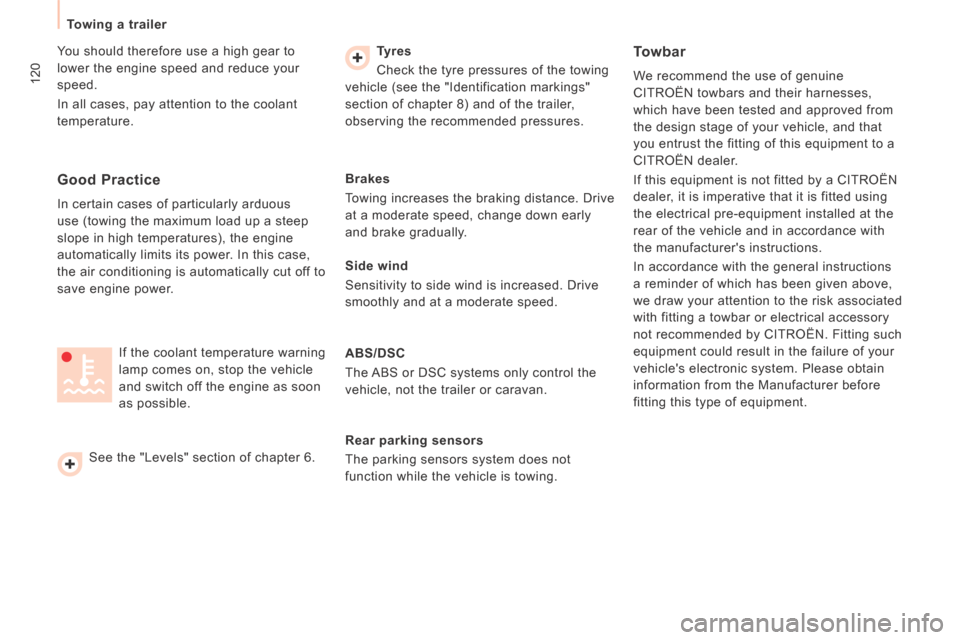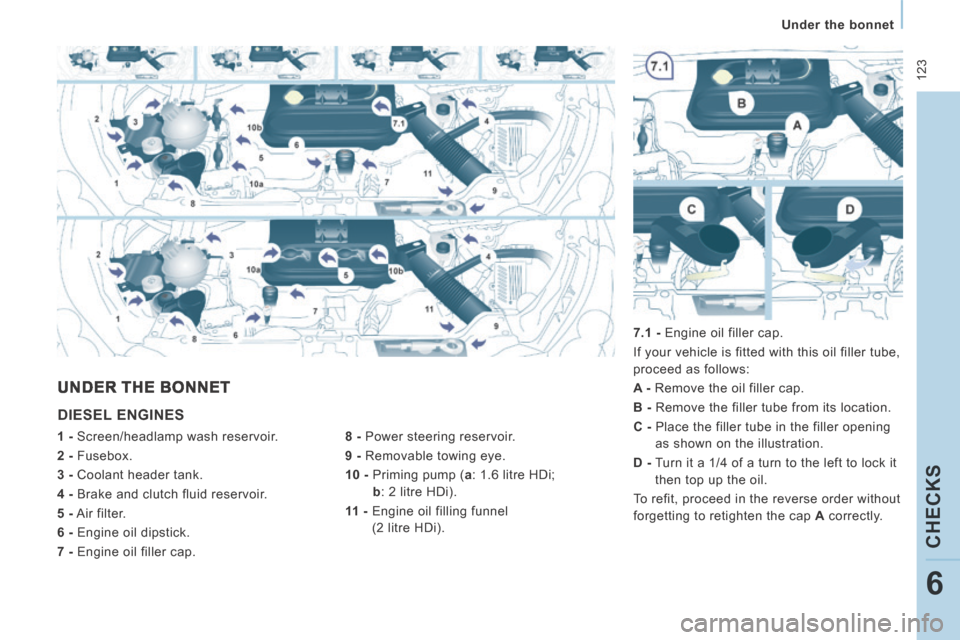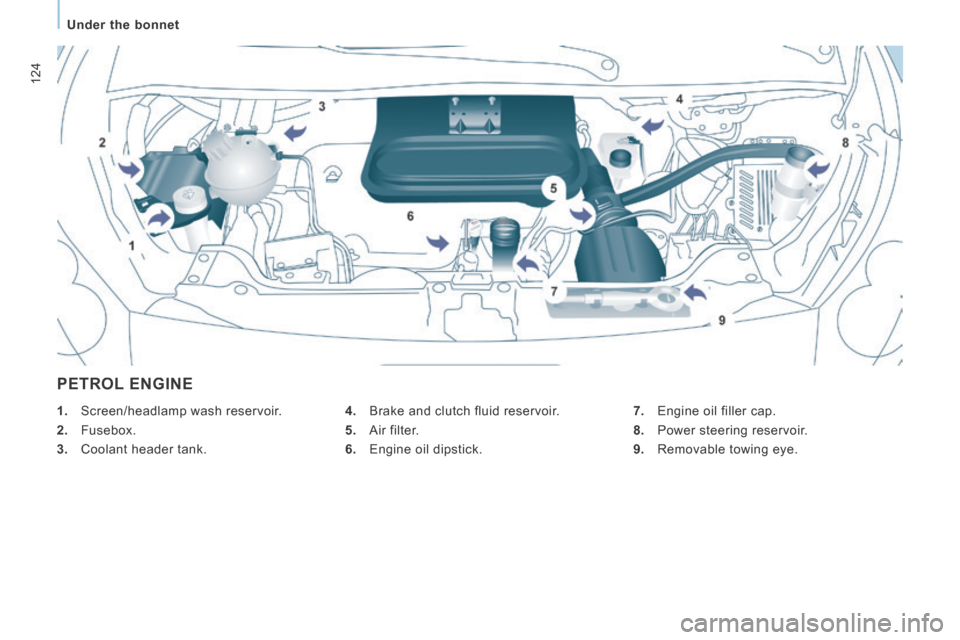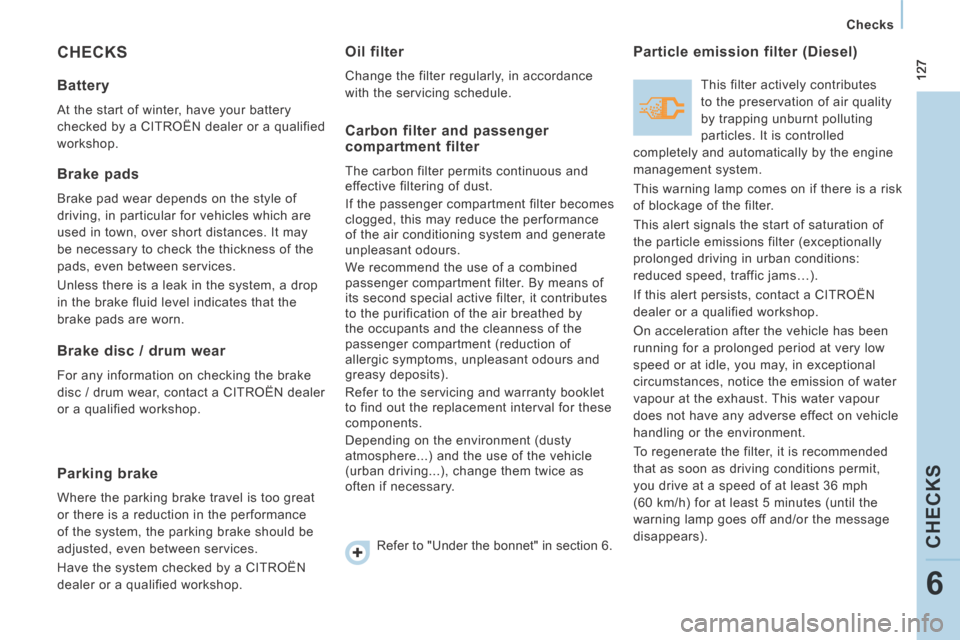tow Citroen JUMPY MULTISPACE 2014 2.G Owner's Guide
[x] Cancel search | Manufacturer: CITROEN, Model Year: 2014, Model line: JUMPY MULTISPACE, Model: Citroen JUMPY MULTISPACE 2014 2.GPages: 260, PDF Size: 13.41 MB
Page 116 of 260

11 4
Child safety
JUMPY-ATLANTE-VP_EN_CHAP04_SECURITE_ED01-2014
(a) To install a child seat on a rear seat, move the seats in front forward,
then straighten the backrest to allow
enough space for the child seat and the
child's legs.
(b) To install a child seat on a rear seat, adjust the rear seat to the fully back
position with the backrest straightened. IUF: seat suitable for the installation of an
I SOFIX U niversal child seat "forward
facing" fitted with an upper strap.
IL-SU: seat suitable for the installation of an
I SOFIX S emi- U niversal child seat,
either:
- "rearward facing" fitted with an upper strap or a support leg,
- "forward facing" fitted with a support leg,
- a carrycot fitted with an upper strap or a support leg. Remove and stow the head restraint
before installing a child seat with
backrest on a passenger seat.
Refit the head restraint once the child seat
has been removed.
To attach the upper strap, refer to the
"ISOFIX mountings" section.
X: seat not suitable for the installation of a child seat of the weight group indicated.
The installation of a carrycot on an outer
rear seat prevents the use of the other seats
in the row.
Page 119 of 260

11 7
Child safety
SAFETY
4
JUMPY-ATLANTE-VP_EN_CHAP04_SECURITE_ED01-2014
(a) Universal child seat: child seat that can be installed in any vehicle using the seat
belt.
(b) Group 0: from birth to 10 kg. Infant car seats and "car cots" cannot be installed
on the front passenger seat.
(c) Consult the legislation in force in your country before installing your child on
this seat.
(d) When a "rearward facing" child seat is installed on the front passenger seat,
the front passenger airbag must be
deactivated. Otherwise the child risks
being seriously injured or even killed if
the airbag is deployed.
When a"forward facing" child seat is installed on the front passenger seat,
the front passenger airbag must remain
active. Remove and stow the head restraint
before installing a child seat with
backrest on a passenger seat.
Refit the head restraint once the child seat
has been removed.
U: seat suitable for the installation of a child seat secured using a seat belt and
universally approved, "rearward facing"
and/or "forward facing".
L-: only the child seats indicated can be installed in the seat in question
(depending on country of sale).
(e) To install a child seat on a rear seat,
move the seats in front forward, then
straighten the backrest to allow enough
space for the child seat and the child's
legs.
(f) To install a child seat on a rear seat, adjust the rear seat to the fully back
position with the backrest straightened.
Page 120 of 260

11 8
Child safety
JUMPY-ATLANTE-VP_EN_CHAP04_SECURITE_ED01-2014
For the optimum installation of a "forward
facing" child seat, ensure that the back of
the child seat is as close as possible to the
backrest of the vehicle's seat, or in contact
if possible.
The head restraint must be removed before
installing a child seat with a backrest on the
passenger seat.
Ensure that the head restraint is stowed or
attached securely so that it is not thrown
around the vehicle in the event of sharp
braking.
Refit the head restraint as soon as the child
seat is removed. Installing a booster seat
The chest part of the seat belt must be
positioned on the child's shoulder without
touching the neck.
Ensure that the lap part of the seat belt
passes correctly over the child's thighs.
CITROËN recommends the use of a booster
seat which has a back, fitted with a seat belt
guide at shoulder level.
ADVICE ON CHILD SEATS
The incorrect installation of a child seat in a
vehicle compromises the child's protection in
the event of an accident.
Check that there is no seat belt or seat belt
buckle under the child seat, as this could
destabilise the seat.
Remember to fasten the seat belts or the
child seat harnesses keeping the slack in
relation to the child's body to a minimum ,
even for short journeys.
For the installation of a child seat using
the seat belt, ensure that the seat belt is
well tensioned on the child seat and that
it is holding the child seat firmly against
the vehicle's seat. If the passenger seat is
adjustable, move it forward if necessary.
At the rear, always leave sufficient space
between the front seat and:
- a "rearward facing" child seat,
- the feet of a child seated in a "forward facing" child seat.
For this, move the front seat forward and, if
necessary, straighten its backrest as well.
Children at the front
The legislation on carrying a child on the
front passenger seat is specific to each
country. Refer to the legislation in force in
your country.
Deactivate the passenger's airbag when a
"rearward facing" child seat is installed on
the front seat.
Otherwise, the child would risk being
seriously injured or killed if the airbag were
deployed. As a safety precaution, do not leave:
- one or more children alone and
unsupervised in a vehicle,
- a child or an animal in a vehicle which is exposed to the sun, with the windows
closed,
- the keys within reach of children inside the vehicle.
To prevent accidental opening of the doors,
use the "Child Lock".
Take care not to open the rear windows by
more than one third.
To protect young children from the rays of
the sun, fit side blinds to the rear windows.
Page 121 of 260

11 9
Towing a trailer
ACCESSORIES
5
JUMPY-ATLANTE-VP_EN_CHAP05_ACCESSOIRES_ED01-2014
For more information about weights,
refer to the administrative documents
(registration document, ...) or to the
"Weights" section of chapter 8.
TOWING A TRAILER, CARAVAN, BOAT, ETC...
Distribution of loads
Distribute the load in the trailer so that the
heaviest objects are as close as possible
to the axle and the nose weight is close to
the maximum authorised without, however,
exceeding it. Cooling
Towing a trailer on a slope increases the
coolant temperature.
As the fan is electrically controlled, its
cooling capacity is not dependent on the
engine speed.
Driving advice
A towed vehicle must free wheel: gearbox in
neutral.
Page 122 of 260

120
Towing a trailer
JUMPY-ATLANTE-VP_EN_CHAP05_ACCESSOIRES_ED01-2014
You should therefore use a high gear to
lower the engine speed and reduce your
speed.
In all cases, pay attention to the coolant
temperature. Tyres
Check the tyre pressures of the towing
vehicle (see the "Identification markings"
section of chapter 8) and of the trailer,
observing the recommended pressures. Towbar
We recommend the use of genuine
CITROËN towbars and their harnesses,
which have been tested and approved from
the design stage of your vehicle, and that
you entrust the fitting of this equipment to a
CITROËN dealer.
If this equipment is not fitted by a CITROËN
dealer, it is imperative that it is fitted using
the electrical pre-equipment installed at the
rear of the vehicle and in accordance with
the manufacturer's instructions.
In accordance with the general instructions
a reminder of which has been given above,
we draw your attention to the risk associated
with fitting a towbar or electrical accessory
not recommended by CITROËN. Fitting such
equipment could result in the failure of your
vehicle's electronic system. Please obtain
information from the Manufacturer before
fitting this type of equipment.
If the coolant temperature warning
lamp comes on, stop the vehicle
and switch off the engine as soon
as possible.
Good Practice
In certain cases of particularly arduous
use (towing the maximum load up a steep
slope in high temperatures), the engine
automatically limits its power. In this case,
the air conditioning is automatically cut off to
save engine power.
See the "Levels" section of chapter 6. Brakes
Towing increases the braking distance. Drive
at a moderate speed, change down early
and brake gradually.
Side wind
Sensitivity to side wind is increased. Drive
smoothly and at a moderate speed.
ABS/DSC
The ABS or DSC systems only control the
vehicle, not the trailer or caravan.
Rear parking sensors
The parking sensors system does not
function while the vehicle is towing.
Page 125 of 260

123
Under the bonnet
CHECKS
6
JUMPY-ATLANTE-VP_EN_CHAP06_VERIFICATIONS_ED01-2014
DIESEL ENGINES
8 - Power steering reservoir.
9 - Removable towing eye.
10 - Priming pump ( a : 1.6 litre HDi;
b : 2 litre HDi).
11 - Engine oil filling funnel
(2 litre HDi).
UNDER THE BONNET
1 - Screen/headlamp wash reservoir.
2 - Fusebox.
3 - Coolant header tank.
4 - Brake and clutch fluid reservoir.
5 - Air filter.
6 - Engine oil dipstick.
7 - Engine oil filler cap. 7.1 - Engine oil filler cap.
If your vehicle is fitted with this oil filler tube,
proceed as follows:
A -
Remove the oil filler cap.
B - Remove the filler tube from its location.
C - Place the filler tube in the filler opening as shown on the illustration.
D - Turn it a 1/4 of a turn to the left to lock it then top up the oil.
To refit, proceed in the reverse order without
forgetting to retighten the cap A correctly.
Page 126 of 260

124
Under the bonnet
JUMPY-ATLANTE-VP_EN_CHAP06_VERIFICATIONS_ED01-2014
PETROL ENGINE
4. Brake and clutch fluid reservoir.
5. Air filter.
6. Engine oil dipstick.
1. Screen/headlamp wash reservoir.
2. Fusebox.
3. Coolant header tank. 7. Engine oil filler cap.
8. Power steering reservoir.
9. Removable towing eye.
Page 129 of 260

127
Checks
CHECKS
6
JUMPY-ATLANTE-VP_EN_CHAP06_VERIFICATIONS_ED01-2014
CHECKS
Battery
At the start of winter, have your battery
checked by a CITROËN dealer or a qualified
workshop.
Brake pads
Brake pad wear depends on the style of
driving, in particular for vehicles which are
used in town, over short distances. It may
be necessary to check the thickness of the
pads, even between services.
Unless there is a leak in the system, a drop
in the brake fluid level indicates that the
brake pads are worn.
Brake disc / drum wear
For any information on checking the brake
disc / drum wear, contact a CITROËN dealer
or a qualified workshop.
Parking brake
Where the parking brake travel is too great
or there is a reduction in the performance
of the system, the parking brake should be
adjusted, even between services.
Have the system checked by a CITROËN
dealer or a qualified workshop.
Oil filter
Change the filter regularly, in accordance
with the servicing schedule.
Carbon filter and passenger compartment filter
The carbon filter permits continuous and
effective filtering of dust.
If the passenger compartment filter becomes
clogged, this may reduce the performance
of the air conditioning system and generate
unpleasant odours.
We recommend the use of a combined
passenger compartment filter. By means of
its second special active filter, it contributes
to the purification of the air breathed by
the occupants and the cleanness of the
passenger compartment (reduction of
allergic symptoms, unpleasant odours and
greasy deposits).
Refer to the servicing and warranty booklet
to find out the replacement interval for these
components.
Depending on the environment (dusty
atmosphere...) and the use of the vehicle
(urban driving...), change them twice as
often if necessary.
Particle emission filter (Diesel)
This filter actively contributes
to the preservation of air quality
by trapping unburnt polluting
particles. It is controlled
completely and automatically by the engine
management system.
This warning lamp comes on if there is a risk
of blockage of the filter.
This alert signals the start of saturation of
the particle emissions filter (exceptionally
prolonged driving in urban conditions:
reduced speed, traffic jams…).
If this alert persists, contact a CITROËN
dealer or a qualified workshop.
On acceleration after the vehicle has been
running for a prolonged period at very low
speed or at idle, you may, in exceptional
circumstances, notice the emission of water
vapour at the exhaust. This water vapour
does not have any adverse effect on vehicle
handling or the environment.
To regenerate the filter, it is recommended
that as soon as driving conditions permit,
you drive at a speed of at least 36 mph
(60 km/h) for at least 5 minutes (until the
warning lamp goes off and/or the message
disappears).
Refer to "Under the bonnet" in section 6.
Page 131 of 260

TOTAL & CITROËN
PARTNERS IN PERFORMANCE AND PROTECTING THE ENVIRONMENT
Innovation in the search for performance
For over 40 year, the TOTAL Research and
Development departments have developed
for CITROËN, lubricants to match the latest
technical innovations on CITROËN vehicles, both
for competition and for everyday motoring.
For you, this is an assurance that you will obtain
of the best performance for your engine.
Optimum protection for your
engine
By having your CITROËN vehicle
serviced with TOTAL lubricants, you
are contributing towards improving
the life and performances of your
engine, while also protecting the
environment.
prefers
Page 138 of 260

136
Repairing a wheel
JUMPY-ATLANTE-VP_EN_CHAP07_AIDE RAPIDE_ED01-2014
- connect the compressor pipe directly to the valve of the repaired wheel.
- connect the compressor's electrical plug to the vehicle's 12V socket again,
- start the vehicle again and let the engine run, Warning, the sealant cartridge contains
ethylene-glycol, this product is harmful
if swallowed and causes irritation to
the eyes. Keep this product out of reach of
children.
The expiry date of the sealant is indicated
under the cartridge.
The cartridge is intended for a single use;
once opened, it must be replaced.
After use, do not discard the cartridge into the
environment, take it to a CITROËN dealer or
to a specialised waste disposal site.
Do not forget to obtain a new sealant
cartridge, available from a CITROËN dealer
or a qualified workshop.
- adjust the pressure using the
compressor (to inflate: switch A in
position " 1 "; to deflate: switch A in
position " 0 " and press button B ), in
accordance with the vehicle's tyre
pressure label (located on the door
aperture, on the driver's side), then
remember to check that the leak has
been sealed correctly (no further
loss of pressure after several miles
(kilometres)),
- remove the compressor, then stow the complete kit,
- drive at reduced speed (50 mph (80 km/h) max) limiting the distance
travelled to approximately 125 miles
(200 km),
- visit a CITROËN dealer or a qualified workshop as soon as possible to have
the tyre repaired or replaced by a
technician.